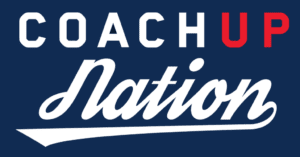Undeniably, the squat is arguably one of the most versatile and useful exercises in any given strength training regimen. In fact, a strong squat translates into more leg power, a higher vertical jump, and a faster sprint time — all incredible benefits across most sports and activities. For the untrained athlete, it’s important to progress properly so that you can minimize the risk of injury while maximizing the load. The weight and stimulus to the muscles over time is what helps them grow optimally. So if you’ve been looking to get into the squatting game, here are some of CoachUp’s favorite progressions we advise athletes to use while starting out.
BODYWEIGHT SQUAT
Just as we need to learn to walk before we can run, we must also learn how to sit down by ourselves before we add any external load. Bodyweight squats help us perfect our form and assess the movement under a mild weight. To bodyweight squat correctly, remember these cues like clockwork.
- Hips first, knees second.
- Sit back, not down.
- Keep the knees out.
- Fill the stomach with air to keep the back straight.
A correct bodyweight squat should be taken all the way to parallel or below. Parallel is defined as the point at which the hips are lower than the top of the knee. It’s important to reach proper depth in order to reduce sheer stress on the knee joints, however it’s only advisable to do so without compromising your lower lumbar spine or upper thoracic spine. Of course, this is not without reason as thoracic spine rounding occurs from poor posture, forward head tilt, and loose shoulders; while lumbar spine rounding happens because of tight hamstrings, tight glutes, or a pelvic tilt.
Once you’re able to perform three sets of twenty repetitions in the bodyweight squat, we’ll be able to progress to adding some weight. However, CoachUp must stress that you take your time and concentrated effort to create good foundations moving forward. Please, do not move on until you’ve nailed this form-specific exercise perfectly. Bad habits or unaddressed flaws will just cause reduced results or injury once you’ve added weight.
GOBLET SQUAT
Goblet squats is next type we advise learning because the positioning of the load is centered in a way that maintains a neutral center of gravity. It also provides a much more granular weight progression as we add an external load for the first time. Unloaded barbells begin at 45 pounds, which is a considerable step up from just the bar, while dumbbells and kettlebells can start as light as 2.5 pounds and progress in that same increment. The correct form for the goblet squat is identical to the bodyweight, with the additional task of holding the dumbbell or kettlebell up against the chest and rib cage. Keeping weight in this position puts the center of gravity in the middle of your body without getting in the way of your ability to squat down all the way. If you’re coming from a bodyweight squat, start with a 5 pound weight in the same manner — three sets over twenty reps. When you can finish these with ease, increase the weight by 5 pounds in the next workout. Then, when you can perform three sets of ten with a 50 pound external load, you can move on to the next progression.
FRONT SQUAT
Once you’ve mastered the barbell back squat, we can begin to add in some variations to stimulate different muscles and tackle any weaknesses. This can be achieved with any variety of grips — but cross-arm grip is best for those lacking elbow and wrist flexibility, however, this may put additional stress on the clavicle and front deltoid muscles. The classic grip for the front squat is Olympic style, which involves wrapping the wrist underneath the barbell as if one were planning on pressing the weight overhead. Changing this center of gravity to the front of the body also forces you to squat down. Thus, your knees will track out further from your body than other squats, but that’s OK. This position significantly reduces the stress on the lower back, but increases the stress on the knees. If you have lower back issues when squatting, consider the front squat as an alternative. Note that most trainees can only front about 80% of their back squat, so make sure to adjust the load appropriately and increase the weight gradually.
OVERHEAD SQUAT
The overhead squat is another alternative that demands the most flexibility, coordination, and stabilization of all of the variants. The benefits of the overhead squat are increased total body activity, increased stabilization training, and is the safest for the back. This is because it’s simply impossible to keep an overhead squat over your head without executing it absolutely correct. The drawbacks, perhaps most obviously, are that this exercise requires considerable flexibility and coordination. Most trainees simply do not have the ankle, hip, and shoulder mobility necessary to execute a proper overhead squat. Finally, the coordination needed to keep significant weight over one’s head usually requires the aid of a coach and is therefore a dangerous exercise to attempt alone. Nonetheless, if you have the flexibility, mobility, and proper coaching, the overhead squat is a great total body exercise that requires a much lighter load than the barbell squat and provides a similar stimulus.
BARBELL SQUATS
The next progression in our series is the Barbell Squat. By now, you should have had plenty of practice working out the mechanics of a proper squat under a considerable load. The replacement of a dumbbell or kettlebell for a barbell introduces a realignment of your center of gravity, which will affect how you set up and execute your squat. Adding a stimulus on your back requires an entirely new set of instructions on how to unrack and grasp the barbell, while dropping into and out of a squat with this new load on your back. Essentially this series breaks down into five cues:
- Grip the bar close and unrack the bar with air in your belly to keep your chest up and your spine in alignment.
- Keep your body tight and your belly full to maximize stability and spinal alignment.
- Sit back into the squat to keep your knees over your feet at all times.
- Keep your knees out in both the descent and ascent, this protects them while also engaging your quads.
- Drive with the hips and glutes, this helps you get back out of the bottom without compromising the knees or back.
From here the sky is the limit as you can load a barbell with as much weight as you can handle. For framing, the World Record for an unassisted squat is 1,014 pounds! Continue your progressive load by achieving three sets with five reps each before adding 5 pounds to the bar. Additionally, we feel like we must again add that you do yourself no good by adding weight before you’re ready — take care yourself, lifting is not a race.
(Related: Read about executing box jumps here.)
Huddle Up
To wrap it all up, we just want to reiterate that you should stick these exercises even if they feel difficult and frustrating at first. At the end of the day, squatting is arguably the single best exercise to add size and strength while also protecting your joints. With proper programming and progression, you’re now ready to reap all the benefits and minimize the drawbacks in this highly functional, compound movement. And, we know, we’re a buzzkill, but please don’t get too far ahead of yourself and take your time with these exercises! You can’t lift if you’re injured, so remember that above all else. If you want more guidance or expertise as you foray into such an exciting type of exercise, consider booking one of CoachUp’s private trainers to help you out. Our skilled team will have you crushing these types of squats in a safe and effective manner in no time. What are you waiting for?
Be prepared for the biggest moments by mastering the small ones in the gym.
How useful was this post?
Click on a star to rate it!
Average rating 0 / 5. Vote count: 0
No votes so far! Be the first to rate this post.




